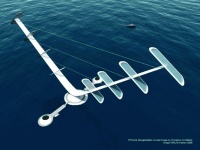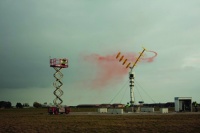
The outline of a wind turbine – tall pylon, three large feather-shaped aerofoil blades rotating in a vertical plane – is so established that it has become emblematic. Wind farms are even represented on maps by a diagrammatic form of the horizontal-axis turbine. According to a UK consortium, however, in the very regions where the wind is strongest, the standard turbine has inherent drawbacks that might see it superseded by a very different design – currently under development and with plans for full-scale testing within five years. So what could be the new iconic outline? Think of something like a rotary washing line.
’The problem with standard horizontal-axis turbines, particularly offshore, is that they have to be so big,’ said Prof Feargal Brennan of Cranfield University, who is leading the research on Project NOVA (Novel Offshore Vertical Axis). ’If you look at offshore wind farms, you’ll often see that several of the turbines aren’t running – that’s because they’ve broken down and they’re extremely difficult to fix.’
With pylons that can be over 100m high and blades up to 60m long, offshore turbines are mighty structures; the largest rotating machines in the world, subject to tremendous stresses from the wind and sea. Moreover, their sites can be difficult to reach, as bad weather and rough seas can render them inaccessible. ’How do you get someone up to the top to maintain them?’ Brennan asked. ’You can’t do it by helicopter, because it’s too hazardous. It has to be carefully scheduled and it’s frequently impossible.’
Unlike a horizontal-axis turbine, vertical-axis machines don’t need to track the wind. Therefore, there are fewer moving parts to worry about and, as an incidental bonus, the developers believe that it will be more ’radar-friendly’ than horizontal-axis turbines.
The NOVA generator looks strikingly different. Instead of a tall tower, the turbine is a wide V-shape, with two wing-like aerofoil arms punctuated by perpendicular sails. Tension wires run between the two arms to support the structure. The base of the V is at or near sea level and turns on a vertical axis. ’The generator for this design isn’t way up in the air, it’s down where it’s more accessible,’ Brennan said.
The NOVA design, originally developed in the late 1990s by aeronautical engineer David Sharpe of Wind Power, is in fact an adaptation of one of the basic designs of vertical-axis turbine, the Darrieus rotor. Looking a bit like a giant egg whisk, these turbines are well established but limited in size. ’One of the difficulties of the Darrieus design is that it has a bearing at the top and the bottom, so you still have the tall mast running up the middle of the rotor,’ Brennan said. ’They spin very quickly, so you have lots of cycles, which can be fatigue cycles.’
The NOVA turbine is actually a Darrieus rotor cut in half horizontally. ’You take away the mast and the top bearing,’ Brennan said. ’The sails on the wings are introduced to mimic the top half of the Darrieus.’
As the air moves over the arms and the sails, they generate lift and this turns the rotor around. It can move relatively slowly because each arm ’sees’ the wind twice – once when it faces onto the wind and once when it’s on the opposite side. But both exposures move the rotor in the same direction, so it doesn’t matter which direction the wind is coming from – an advantage shared by all vertical-axis turbines.
This means that, unlike a horizontal-axis turbine, vertical-axis machines don’t need to track the wind. Therefore, there are fewer moving parts to worry about and, as an incidental bonus, the developers believe that it will be more ’radar-friendly’ than horizontal-axis turbines.
Scaling up the prototype
The consortium has so far produced one working model, at a 5kW capacity; this was 5m high, with 7m-long wings. This, Brennan explained, was to prove the concept and to validate numerical models, and has been a success. ’It is a composite construction, although not very advanced,’ he said.
The next phases will consist of careful scaling up. ’On the way to the full-scale test, which is likely to be in the water by 2015, we anticipate building a 50kW model, a 500kW and a 2MW. But the full 5MW is likely to be the first one that’s tested offshore,’ he added.
The final model is likely to look different from the architect’s vision. ’The relative dimensions between the arms and the sales have now been optimised; the images look rather wide compared with their depth,’ Brennan said. ’And the number of sails will change with the size. A 12MW model would look quite different from a 5MW.’
The full-scale version could be fixed to the sea bed or could be sited on a floating platform. ’They could potentially go into much deeper water than a horizontal-axis turbine,’ Brennan said. ’And that would help with maintenance – for a refit, you’d be able to tow them into shore.’

’As horizontal-axis devices need to track the wind, their radar signature varies, depending on which direction you approach them from relative to the wind,’ Brennan said. ’But the NOVA turbine always produces the same radar signature, regardless of the wind direction or how you’re approaching it.’
But perhaps the biggest advantage of the design is its stability. Vertical-axis turbines are not only difficult to maintain, they are an inherently problematic shape: tall and thin with a heavy weight at the top. Their top-heaviness means that they have to be counterweighted at their base or sited on the sea bed. The NOVA design, however, is naturally bottom heavy; more stable and suited to being scaled up without concerns about the stresses on the components.
’When each blade on a horizontal turbine rotates, it has to push and pull its own weight up and down; that’s known as a dynamic self-weight,’
The potential for scale up was one of the factors that attracted the Energy Technology Initiative (ETI). ’The ETI wants to expand the supply chain for wind technologies into the UK,’ Brennan said, ’and that means developing new technologies. The studies that were done on David Sharpe’s design showed that it was likely to lend itself to very large offshore machines.’
If you’re building an airliner, you’re going to have anything up to 800 people on board, so the consequences of failure are huge. For a wind turbine they aren’t as great, so the same level of safety factors and failsafe mechanisms don’t need to be employed.
Prof Feargal Brennan
Project NOVA is a collaboration between Wind Power, along with Cranfield, Sheffield and Strathclyde universities and Qinetiq. Offshore-energy specialist OTM Consulting is managing the project and Welsh offshore engineering firm James Ingram and Associates is providing offshore wind-farm development experience. Funded by a share of a £20m grant from the ETI, the aim of the project is to have 1GW of generating capacity from NOVA turbines – probably comprising 200 5MW units, which Brennan said is the smallest capacity the consortium will consider – by 2020, via a large-scale demonstrator, to be installed offshore by 2015.
To put this into context, the wings of a 5MW turbine would be the largest composite structure ever built. The turbine would stand 70m high, with each wing 120m long. Spread the V out flat and it is twice the size of the wingspan of a Boeing 787, whose wings are the current composite-structure record holders.
’In many ways, the wings wouldn’t be as complex as aircraft wings, mostly because of the safety case,’ Brennan said. ’If you’re building an airliner, you’re going to have anything up to 800 people on board, so the consequences of failure are huge. For a wind turbine they aren’t as great, so the same level of safety factors and failsafe mechanisms don’t need to be employed.’
The 5MW capacity is larger than any current commercial horizontal-axis turbine, which tend to be around 2-3MW – although 5MW units are in development.
’By the time we come to build a full-scale demonstration model, we expect that 5MW horizontal units will be available,’ Brennan said. ’But we have done some costings and, although we have to be rather guarded, the costs for a NOVA turbine look very competitive with horizontal-axis machines.’




April 1886: the Brunkebergs tunnel
First ever example of a ground source heat pump?